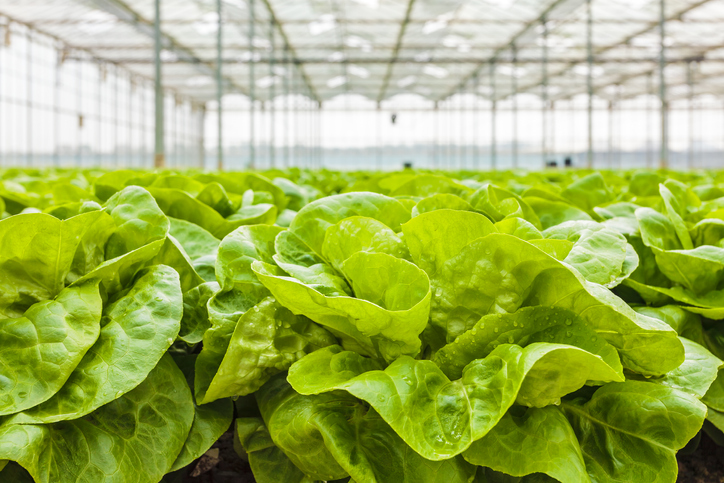4 Benefits of Greenhouse Production for Fresh Produce
Are you deciding if greenhouse growing is the next logical step for your produce business? Learn more about the benefits of greenhouse production.

Reliable and consistent production of fresh, high-quality produce means reducing unpredictability. Many businesses have turned to greenhouse production as an ideal solution.
With climate control systems that lead to higher yields, improved quality, and consistent seasonality, there are numerous benefits from growing in greenhouses. However, before deciding that greenhouse growing is the next logical step for your business, you may want to compare the benefits of greenhouse produce with the challenges that come along with it.
We’ll go over what you need to know in this article, as well as how technological solutions like Silo can help you make the most of your produce business, whether you make use of greenhouse techniques or not.
What is greenhouse production?
Greenhouse production is a method of growing fresh produce in a controlled environment. It’s specifically designed to maximize climate control and light optimization.
This may include factors like providing the ideal temperature, humidity, CO2 levels, and access to sunlight for plants to promote optimal growth and yield potential while protecting them from extreme weather conditions.
Greenhouse environments are often managed according to the needs of the crop and leverage automated climate control systems, irrigation systems, and supplemental lighting to ensure that each plant receives the necessary conditions for maximum growth.
The benefits of greenhouse production
The benefits of producing in a greenhouse are as follows.
1. Improved yield and quality
The increased quantity and quality of products grown in greenhouses is one of the primary advantages of growing in greenhouses.
Produce grown in greenhouses is exposed to more consistent environments in terms of temperature, humidity, and light, all of which contribute to increased yields and improved overall product quality.
The use of hydroponics or other soilless growing techniques in greenhouses specifically helps in this regard, since they enable precise control of both the nutrients and the water used in the cultivation process.
Greenhouses can also lengthen growing seasons, allowing growers to flourish in regions where producing food outside would normally be difficult to do so. The result: fresh food throughout the entire year.
2. Pest control
Greenhouses allow for integrated pest control strategies, which helps minimize the amount of chemical pesticides used.
Greenhouse vegetable production, for example, allows for the cultivation of a wide range of vegetables, in an environment that not only optimizes growing conditions, but reduces the risk of pests and diseases, as they become easier to manage and avoid in controlled settings.
3. Water conservation
Hydroponics and other soilless growing techniques employed in greenhouses can lead to more effective water use since the water can be recirculated and reused. Greenhouses have the benefit of capturing and recycling water, which cuts down on water use and resource waste.
4. Sustainability
Another benefit of greenhouse production is that it lends itself well to organic and sustainable agriculture, as the regulated environment permits the use of organic growing methods.
And because everything is produced closer relative to where the produce is sold and bought, less transportation is required, resulting in a lower carbon footprint.
Challenges in greenhouse production
Producing in greenhouses doesn’t come without challenges, however.
1. High initial cost and labor
Setting up a greenhouse requires a high investment initially, since it requires specialized equipment and materials. This can include greenhouse buildings, heating and cooling systems, artificial lighting, and watering systems. These expenses can be substantial, particularly for large scale operations.
The need for skilled manpower to manage and maintain greenhouses is another factor that contributes to the overall high initial cost associated with greenhouse cultivation.
2. Dependence on energy
Greenhouse crops need consistent energy inputs for heating and lighting to maintain a stable and ideal growth environment. The cost of these energy inputs can be high.
Manufacturing in greenhouses is also susceptible to technological problems and power outages, both of which have the potential to halt production and result in financial loss.
3. More difficulty in identifying certain pests
Despite the fact that greenhouses can help lower the risk of pests and disease transmission, it doesn’t completely eliminate it. It’s also possible that pests and illnesses will not be as evident as they would be in an outside environment.
It may, as a result, be more challenging to identify and eradicate these problems when they do occur.
Make the most of your market presence with Silo
Greenhouse production has a number of benefits, and as the demand for fresh produce continues to grow, it has the potential to play an increasingly important role, both in the United States and globally.
It’s important to make your business agile to react to changing market scenarios. Silo can help you with this. Silo allows you to optimize your business processes end-to-end.
Streamline your operations, manage your finances, and improve your decision-making with features for accounting, inventory management, project management, customer relationship management, and more.
Book a demo with Silo today!
Want to book a demo with us?
Add your info and we’ll get one scheduled with you.